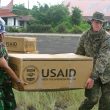Focusing on ‘what,’ not ‘how’
But such weighty decisions will be made at a later date. Thiessen and McEwen both acknowledged that the latest SOR is focused on "what," rather than "how."
"We tried to shy away from anything that had to do with the design of the network, which is the 'how' part," Thiessen said.
Indeed, several capabilities deemed important to first responders were excluded from the launch requirements, most notably push-to-talk (PTT). In fact, what constitutes "public-safety grade" — a big bone of contention within the first-responder community, which fears that the commercial technology that this network will rely upon won't be up to the task — was given only cursory attention, according to Thiessen.
"Because the document was qualitative and not quantitative, there was a struggle … to talk about what public safety refers to as 'public-safety grade,'" Thiessen said. "But there is an expectation that this will be public-safety grade. So, while we didn't define what that meant in this document, it does spell out what the expectation is, so that it isn't lost on FirstNet."
The definition will come in a later revision, as will guidance on what PTT services will look like on this network. There is a very specific reason why PTT was not addressed initially, according to Thiessen.
"There is a voice expectation, but there are a lot of different ways you can do that," he said. "Cellular telephony, as a mode of operation, is very well understood in a cellular broadband network. But there's a little bit of angst about whether all of the mission-critical aspects of PTT would be there … and they wanted to see what shakes out from a standards perspective."
In fact, 3GPP — global organization that develops the LTE standard — has identified public-safety communications as the "No. 1 opportunity," for LTE Release 12.
"That's good news," he said. "We've been working very hard on this, but it's not just the U.S. that's pushing a public-safety agenda in 3GPP anymore. [For example], NPSTC has an MOU with TETRA to work on broadband. So, having the TETRA folks participate was critical to showing the commercial operators and manufacturers within 3GPP that this is really a global public-safety market, and not just a U.S. market."
Meanwhile, work continues within NPSTC — working closely with PSCR — to define public-safety-grade PTT . Since September, one working group has focused on mission-critical voice, while another has been examining direct-mode voice and data. The groups hope to provide a recommendation by the end of April, according to Steve Devine, chairman of the mission-critical-voice group and interoperability program manager for the Missouri Department of Public Safety.
There are a lot of moving parts to this, but Devine believes that, no matter how public-safety PTT ultimately is defined, such communications need to be managed at the local level.
"You can give all kinds of capabilities to somebody, but someone has to manage this locally," he said. "Let's look at prioritization, for example. Will users be prioritized at a static level, or do you prioritize ambulance people at a train wreck over firefighters in hazmat suits? You can — and will — dynamically prioritize those users based on the needs of the incident."
As if this wasn't challenging enough, the first-responder community also has to determine how to roll out all of these new capabilities while maintaining their existing LMR systems. This is something that they'll likely need to do for at least a decade — perhaps two or three decades, if not longer — until the nationwide broadband network is deployed and the migration to LTE is complete.
"Now, we still need to fund our LMR networks, but [government officials] — and these are bottom-line budget people — are asking, 'When can we stop doing this, so that we can start doing that?'" Devine said. "But you can't walk away from [LMR], because that's your mission-critical voice.
"So, we're going to have to keep more balls in the air in the future, and we're still going to have to keep those balls funded," he continued. "It's going to be a challenge, because while we're educating people about the new technologies, we also have to educate them that they can't leave their old technologies — that's the hard part."
Devine contemplated the last time the public-safety communications sector faced such a profound paradigm shift.
"It probably was when they went wireless in the first place, putting mobile radios into vehicles and getting rid of the old call boxes."













